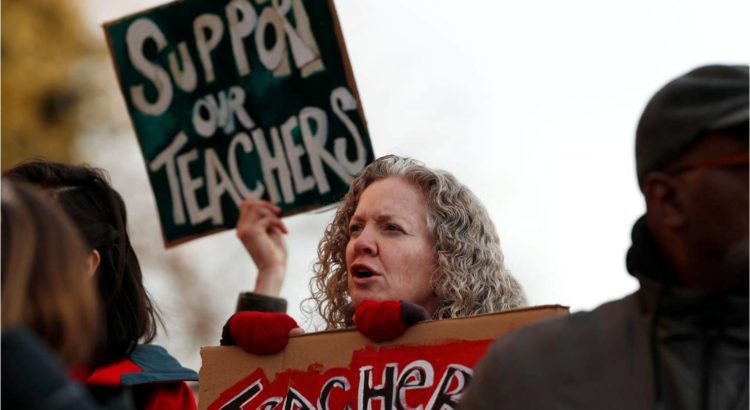By: Alex Caputo-Pearl.
More American workers — 533,000 — were involved in strikes or work stoppages last year than at any point since 1986, according to Labor Department data released Friday. The driving force behind this remarkable development: educators who are finally fed up with years of cutbacks and government indifference to public education. The two largest labor actions of 2018 were statewide teacher strikes in Arizona (involving 81,000 teachers and staff) and Oklahoma. “Statewide major work stoppages in educational services also occurred in West Virginia, Kentucky, Colorado, and North Carolina,” the Labor Department noted.
In 2019, teachers will continue standing up for public education. Last month, 33,000 educators in Los Angeles picketed, and thousands of parents and students rallied in support. On Monday, Denver teachers went on strike for the first time in 25 years.
The Angeles teachers succeeded in winning a new contract that, in addition to a 6 percent pay increase, brings reductions in class size; more nurses, counselors and librarians; and less standardized testing. The contract also includes a mayoral and district endorsement of a state school funding measure called Schools and Communities First; a district call for a moratorium on charters; a reduction of searches that criminalize students; and an immigrant defense fund.
The Los Angeles teachers strike, the first in 30 years, was one of the most stirring events I’ve witnessed in my long experience with public education. I grew up attending Prince George’s County public schools in the 1970s and 1980s, then joined Teach for America in its first year, 1990, and moved to Los Angeles. I taught for 22 years in South Los Angeles and helped start an organization with parents and students called Coalition for Educational Justice. In 2014, I was elected president of United Teachers Los Angeles, or UTLA.
I was proud to lead the organization that is finally setting Los Angeles schools on a better pathway after years of battling forces arrayed against public education in California, as they are across much of the country.
California is the fifth-largest economy in the world, yet in measures of states’ per-pupil spending, Education Week ranked California 46th in the nation for 2017, and the California Budget and Policy Center pegged it at 41st in 2015-2016. California also permits the unregulated growth of privately run charter schools, undermining neighborhood public schools.
The over 98 percent participation in the strike by Los Angeles teachers, and strong support from parents, reinforced three basic premises: People will fight for reinvestment in public neighborhood schools and against privatization. Unions and parents will work together for the benefit of students. And strikes work.
Another teacher strike may come soon in Oakland, Calif., and mass teacher protests are planned in the state capitals of Maryland and Texas. These labor actions are essentially demands for reinvestment after decades of deliberate underfunding of public schools.
In the 1990s and 2000s, pushed by conservative think tanks and the corporatization of the Democratic Party, a bipartisan consensus seemed to emerge in Congress and many statehouses. The emphasis regarding public neighborhood schools shifted from providing adequate funding to de facto privatization through vouchers and the charter industry. Federal efforts stalled in fully funding Title I (a 1965 provision directing federal help for schools and school districts with a high percentage of students from low-income families) and the 1975 Individuals with Disabilities Education Act. Many states also cut education spending. Privately run schools with less accountability would now receive public money, further draining public schools of already scarce resources.
Because of ideology and economic philosophy, the current Republican Party leadership will not lead on reinvestment in neighborhood public schools. For the Democratic Party, it is time for leaders to choose a side. Several potential Democratic presidential candidates expressed support for the Los Angeles teachers strike, but few offered ways to adequately fund public schools. The preliminary budget of California’s new Democratic governor, Gavin Newsom, increased spending for K-12 and community college by $2.8 billion, for a total of $80.7 billion, but that is not enough after years of austerity in a state with more than 6 million public-school students.
Parents and students supported the teachers in the Los Angeles strike because they wanted to win on matters such as class size. But they also supported the strike because it articulated some basic truths: Students aren’t getting what they need. In the richest country in the world, the issue is not a lack of money but a lack of political will. If neither political party is capable of leading on reinvestment, teachers and parents and students will continue taking to the streets to defend the essential civic institution of public education.
Source of the article: https://www.washingtonpost.com/opinions/why-teacher-strikes-show-no-signs-of-slowing-down/2019/02/11/5b8a6d80-2e18-11e9-8ad3-9a5b113ecd3c_story.html?noredirect=on&utm_term=.5a3c8a468298







 Users Today : 0
Users Today : 0 Total Users : 35402775
Total Users : 35402775 Views Today :
Views Today :  Total views : 3331921
Total views : 3331921